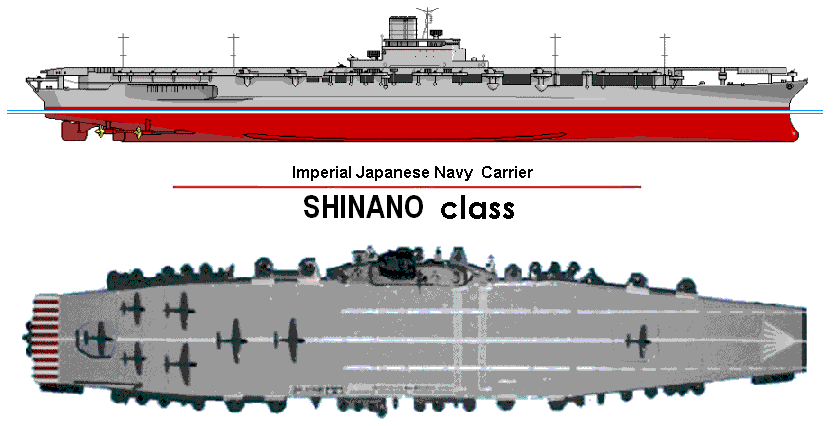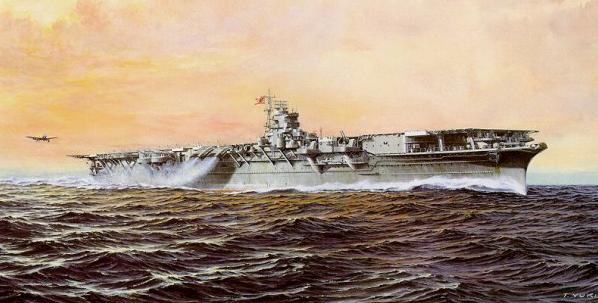
Imperial Japanese Navy - SHINANO Aircraft Carrier ==========================================================================

Shinano was an aircraft carrier operated by the Imperial Japanese Navy in World War II. It was laid down as the third of five projected Yamato-class superbattleships.
Shinano's keel was laid down in June 1940 at Yokosuka Navy Yard (now United States Fleet Activities Yokosuka), but construction was suspended in the summer of 1941 to free manpower and resources for approaching hostilities. After disastrous losses at the Battle of Midway, the decision was made to convert Shinano into an aircraft carrier.

The conversion process for Shinano placed a heavy emphasis on armor. For example, the flight deck was designed with 17,700 tons of steel—enough to withstand a 1,000-pound bomb. With a full-load displacement of almost 72,000 tons, it was the largest aircraft carrier ever built until the commissioning of the supercarrier USS Enterprise in 1961. Shinano was designed as a support carrier, using its extensive machine shops and large fuel capacity to service aircraft operating on other carriers. It would have had a very small air group of its own but a large number of unassigned aircraft to replace losses on other carriers.
The ship's very existence was kept a closely-guarded secret. A tall fence was erected on three sides of the graving dock, and those working on the conversion were confined to the yard compound. Serious punishment—up to and including death—awaited anyone who breathed a word about Japan's new carrier. As a result, Shinano was the only major warship built in the 20th century to have never been officially photographed during its construction.
Under these conditions, Shinano was launched on October 5, 1944 and formally named on October 8. She left the yard for builders' trials on November 11, 1944, and was commissioned on November 19.

Because of her prodigious bunkerage and ordnance stowage space, it was intended that she operate as both a carrier and a replenishment vessel. Ironically, she was sunk by the U.S. submarine Archerfish before she ever launched a plane, the victim of faulty damage control and her watertight compartmentation not yet being installed (which begs the question, whose bright idea was it to leave harbor for another port for final fitting out, in 1944, with the Inland Sea crawling with our subs, without all her watertight doors installed? Not a real bright move.)
On November 28, Shinano sailed for Kure for further outfitting, escorted by three destroyers. Captain Toshio Abe commanded a crew of 2,176 officers and men. In addition, there were 300 shipyard workers and 40 civilian employees. Abe opted for a nighttime passage after finding out that he had no available air support for a daytime passage. The destroyer commanders argued for a daytime passage, citing the weariness of their crews (they had been involved in the Battle of Leyte Gulf) and the need for vital repairs. However, Abe felt that a daytime passage without air cover was an invitation to disaster.
Japan's military commanders had high hopes for Shinano, hoping that it could turn the tide in a conflict that Japan was obviously losing. In fact, they placed so much importance on the vessel that Abe was slated to be promoted to rear admiral when he arrived at Kure. However, at the time it left on its maiden voyage, most of its compartments had not been tested for watertightness. Although all but 700 members of the carrier's crew had seen combat duty, they weren't well-trained in damage control procedures. Also, four of its 12 boilers were not in service for want of parts. Abe actually requested a delay in the sailing date because of these factors, but was turned down almost out of hand by headquarters, largely due to fears of an impending American bombing raid on the home islands. Even with only eight functioning boilers, Abe was able to coax 20 knots out of Shinano—still faster than the American subs that roamed the waters off the south coast of Honshû.
Shinano had only been at sea for a few hours when it was sighted by USS Archer-Fish, a Balao-class submarine under the command of Commander Joseph F. Enright. Although Abe had far superior firepower at his disposal, he thought that Archer-Fish was the flagship of a wolf pack. In Abe's view, Archer-Fish was a decoy to lure away one or more of the screening destroyers, giving the rest of the pack a clear shot at Shinano. In fact, he actually ordered one of the destroyers to turn back when he spotted it making a run at Archer-Fish—thus losing his best chance to send it to the bottom. Abe's every move was defensive in nature, with his main focus on getting Shinano to Kure safely. Abe's mood became even more defensive after finding out one of the main shaft bearings had overheated—cutting his top speed to 18 knots, the same speed as most American subs. In his haste to avoid the supposed wolf pack, his zigzagging put Shinano right in the path of Archer-Fish a few hours later.
At 03:17, Archer-Fish fired six torpedoes. Four shallow-running torpedoes struck Shinano between the anti-torpedo bulge and the waterline. Although the ship initially continued under way, it lost power around 06:00. The crew was unable to contain the flooding and Shinano sank at 11:00. Approximately 1400 of the 2500 crew died. The dead included Abe and both of his navigators, who went down with the ship.
American Naval Intelligence didn't even know Shinano existed when it left port, but had suspected there was a third Yamato-class battleship. Archer-Fish was initially given credit for sinking a 28,000-ton carrier. It wasn't until after the war that the Americans discovered that Archer-Fish had brought down a 72,000-ton leviathan.
Postwar analysis by the US Naval Technical Mission to Japan concluded that Shinano had serious design flaws. Specifically, the joint between the antiprojectile armor on the hull and the anti-torpedo bulge on the underwater body was poorly designed; Archer-Fish's torpedoes all exploded along this joint. Additionally, the force of the torpedo explosions dislodged an H-beam in one of the boiler rooms. The dislodged beam turned into a giant battering ram that punched a hole between two of the boiler rooms. In addition, the failure to test for watertightness played a role. Survivors claimed that they were unable to control the flooding because the water poured in too fast; some claimed to have seen rivets between seams burst and allow water to surge through.
To this day, Shinano is the biggest warship to have been sunk by a submarine.
=================================================================================
NB: The above text has been collected / excerpted / edited / mangled / tangled / re-compiled / etc ... from the following online sources :
IJN - SHINANO class Aircraft Carriers - wikipedia article #1
IJN - YAMATO class Battle Ship - wikipedia article #2
IJN - SHINANO class Aircraft Carriers - www.globalsecurity.org
IJN - SHINANO class Aircraft Carriers - www.combinedfleet.com


